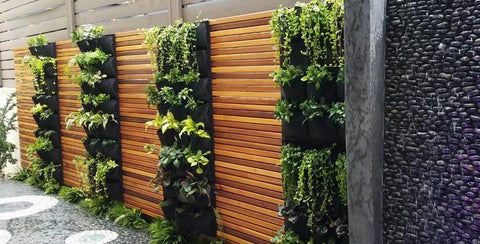Pickup your order for free
Pickup your order for free

Though gardens have traditionally been outside spaces that allow us to wander amongst the plants themselves, increasing city life has led to space becoming a premium which doesn’t allow for many green spaces. This has meant the designers have had to increasingly come up with innovative and contemporary garden spaces which can be used for both pleasure and function. And, one area that is becoming increasingly popular in the cityscape is vertical gardening.
Some of the most familiar vertical gardens are those understood as living walls; a concept where low growing and small plants are placed into a matrix which is then fixed to a wall. Such designs can be immense in their size and can cover the entire sides of buildings to create a living structure. They are also increasingly being used inside building spaces too, such as foyers and receptions, to create a contemporary and eco-friendly ambiance for people to enjoy. The Musee de quai Branly in Paris (left) is one space which has a remarkable vertical garden created by Patrick Blanc. Another work of this garden designer’s can be seen in London, on the Athenaeum Hotel, showing that vertical gardening is not only for tropical regions, but can be used to great effect in temperate urban areas too.

However, not all vertical gardens are of this grand scale, and the increasing popularity of utilising the concept in home spaces, is rising. This has led to many companies now providing products which you can use to create a vertical garden in your own home. From livening up the side of your house or patio using a vertical wall of plants instead of the traditional climbers, to podiums of pots which you can plant herbs and vegetables in to grow on your balcony, vertical gardens are becoming increasingly common.
There are many advantages to vertical gardens. Firstly, one of the main reasons which has led to the innovation of growing upwards is the lack of space, and vertical gardening allows you to grow plants in the smallest of areas. Using a combination of little plant species, living walls on both a commercial and small home-grown system can look wonderful, maximising growing space and offering a green outlook to those who want to avoid views of concrete and bricks. So, there is also the aesthetic benefit to think of, allowing cities and thriving metropolises which are traditionally sparse of greenery, to create spaces which are both beneficial to mental and physical health. In addition, those who want to grow vegetables at home but lack a garden can utilise vertical gardens to grow easy foodstuffs such as herbs and salads (right).

Plants are well known for their positive effects, which cover a wide degree of aspects. It is well regarded that a planted area of greenery and flowers is less likely to attract vandalism and crime, helping to instil a positive setting for an area. Plants are also very good at absorbing pollutants and chemicals which may be in the air, filtering out damaging toxins and releasing oxygen. Both of these factors are especially important in towns and cities, and the use of vertical gardening may not only increase the physical health of residents, but offer subtle social reforms to substantially increase an areas positive ambiance. Another environmental benefit is that water can also be carefully controlled. Whereas in a garden setting where watering plant growth simply results in water disappearing into the ground, in vertical gardens, water can be filtered down through living walls of plants, collected and reused again, minimising the amount of wastage of this vital commodity.
Vertical garden use is increasing, maximising the space that is available and offering many more people the opportunity to grow and enjoy plants. And, with its numerous benefits, the vertical gardening phenomenon is set to only increase in popularity.